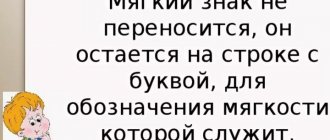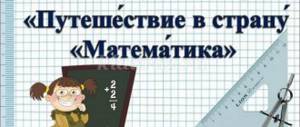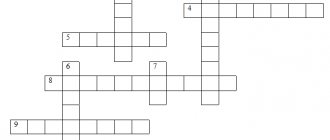Testing and measuring materials on “Music Theory and Solfeggio” (tests) test on the topic
Test tasks in solfeggio
intended for students in grades 3-7 of children's music schools and children's art schools.
Can be used to form a bank of questions in preparation for creative competitions for the best knowledge of material in subjects of the musical theoretical cycle
3rd grade
1. The mode in which b.3 is formed between the I and III steps is called... A) major B) minor C) sequence 2. The structure of the natural minor: A) 1, 1, ½, 1, 1, 1, ½ B) 1, ½, 1, 1, ½, 1, 1 B) 1, 1, ½, 1, 1, 1, ½
3. Transposition is... A) the transition of unstable sounds into stable ones B) moving the melody to a different height C) performing the melody with the voice
4. Starting a melody with a weak beat is A) sequence B) rhythm C) beat
5. A pause is... A) a break in the sound B) a sign of silence C) all answers are correct
6. Introductory sounds are A) I, III, V stages B) II, IV, VI, VII stages C) II, VII stages
7. What duration does a dot to the right of a quarter note add? A) eighth note B) quarter note C) half note
8. In what key is the tetrachord b-do-re-mib the upper tetrachord? A) in B major B) E minor C) E b major
9. Which intervals are perfect consonances? A) part 1, part 4, part 5, part 8 B) m.3, b.3, m.6, b.6 C) level 4, level 5
10. The tonality parallel to A major is... A) C major B) F minor C) F# minor
11. How many inversions does a triad have? A) three B) four C) two
12. UV.2 contains... A) 2 tones B) 1.5 tones C) 3 tones
13. In what form of minor does lv.2 appear? A) natural B) harmonic C) melodic
14. How many m.3 are there in degrees of natural major? A) four B) one C) three
4th grade
1. What triad tone is the quartet-sex chord based on? a) on the third b) on the fundamental c) on the fifth
2. The dotted rhythm is expressed by durations: A) eighth, 2 sixteenths B) eighth with a dot and a sixteenth C) eighth, quarter, eighth
3. Triton is A) a triad on the III degree B) an interval in which there are 3 tones C) m.3 and b.3
4. Which key has more key characters? A) A major B) F minor C) C minor
5. The interval “lab-re” is... A) uv.4 B) part 4 C) part 5
6. A seventh chord consists of... A) sevenths B) seven sounds C) thirds
7. The tonalities of Mb major and C minor are A) parallel B) of the same name C) stable
8. The sound solb is the top of m.6. What sound is its basis? A) si B) сb C) to
9. In what key will the triad fa#-la-do# be S 5|3? A) B minor B) F# minor C) C# minor
10. D6|4 is built on... A) II stage B) VI stage C) V stage
11. Uv.4 is built on... A) IV degree of natural minor B) VII# degree of harmonic minor C) all answers are incorrect
12. When converted, m.3 will go into... A) b.3 B) b.6 C) b.7
5th grade
1. What sound is missing in the harmonic minor scale gabcd-_?_-fis-g A) es B) e C) f
2. What chord does S 6|4 resolve into? A) in T 5|3 B) in D7 C) in T6
3. What chord consists of b.3 + b.4? A) T5|3 B) M6 C) D7
4. The interval dis-c is A) b.6 B) m.7 C) mind.7
5. ¾ time signature is usually used in A) polka B) waltz C) march
6. Which rhythm group is a triplet? A) eighth note and 2 sixteenth notes B) eighth note, quarter note, eighth note C) 3 eighth notes, top 3
7. In what keys will the h-dis-fis-a chord resolve? A) H-dur, h-moll B) E-dur, e-moll C) Es-dur, es-moll 8. Shifting the emphasis from a strong beat to a weak one called... A) triplet B) upbeat C) syncopation
9. In 3/8 time, each beat lasts... A) one eighth B) one quarter C) one sixteenth
10. How many tritones are there in natural major? A) three B) four C) two
6th grade
1. Harmonic sound in minor is A) VI b step B) VII b step C) VII# step
2. In the interval “fis-e” the qualitative value is equal to: A) 5 tones B) 6 steps C) 7 steps
3. How many Um are 5/3 in harmonic major? A) one B) two C) none
4. In the key of H-dur, the h-dis-fis chord should be designated as... A) B 5/3 B) M 5/3 C) T 5/3
5. Intervals that can only be constructed in harmonic modes are called... A) characteristic B) tritones C) dissonances
6. How many steps are there in the pentatonic scale? A) seven B) six C) five
7. What chord consists of m.3+ m.3? A) M 5/3 B) D7 C) all answers are incorrect
8. What chords are built on the 2nd degree? A) mind.5, Mind. 5/3, D 6/5 B) Mind VII 7, M VII 7, D7 C) Mind 5/3, D43
9. When resolving the introductory seventh chords directly into the tonic triad, in T 5/3 A) the fundamental tone B) the third tone C) the fifth tone is doubled
10. Write the syllabic meanings of the sounds (keeping their order) b- eis – gis – a – h – as – es a) si – mib – sol# – la – sib – la# – mi b) sib – fa – sol – la - si - la# - do c) sib - mi# - sol# - la - si - lab - mib
7th grade
1. The a-fis interval is defined as m.7. What's wrong with the definition? A) letter only B) number only C) letter and number
2. In an altered major, when moving downward A) the II, IV, VI steps are raised B) the VI, II steps are lowered C) the VI, IV, II steps are lowered
3. What characteristic interval is built on the third degree of the harmonic minor? A) level 2 B) level 5 C) level 7
4. Which of the opening seventh chords has more minor thirds in its structure? A) in M VII 7 B) in Um VII 7 C) there are no minor thirds in their composition at all
5. Uv 5/3 in Es-dur consists of sounds A) df-as B) f-as-c C) ces-es-g
6. Where does the f-as-bd chord resolve? A) in Des-dur B) in Es-dur C) in e-moll
7. How is the word “dur” translated from Latin? A) “hard” B) “soft” C) “major”
8. In the chromatic minor scale, when moving upward, all steps are repeated, except... a) I, V b) III, VI c) IV, VI
9. How many other enharmonic substitutions does the sound “fis” have? A) three B) one C) two
10. Which pair of characteristic intervals contains a stable sound? A) level 2, level 7 B) level 5, level 4 C) level 5, level 4
Solfeggio tests, 1st grade
Solfeggio tests, 1st grade
Questions
1. A duration equal to two eighths is called:
a) half b) quarter c) whole d) eighth
2. In a seventh:
a) 6 steps b) 3 steps c) 1 step d) 7 steps
3. The notes of the treble clef are written in:
a) upper register b) in the middle register c) in the middle and upper registers d) in the lower register
4. Flat lowers the sound by:
a) tone b) ditone c) semitone d) prima
5. Between the second and third lines in in the treble clef the note “hidden” in the word is written:
a) craft b) minor c) surname d) week
6. Unstable steps in C major:
a) B, D, F b) C, E, G c) B, D, F, A d) B, F, A
7. The non legato stroke means
a) connected b) incoherent c) abrupt d) emphasized
8. On the third line in the bass clef the note “hidden” in the word is written:
a) domra b) drop c) strongman d) shrimp
9. In the sequence of sounds of the F major scale - fa-la-do-fa - the following are missing:
a) introductory steps b) stable steps c) unstable steps d) tonic triad
10. A half note consists of:
a) one quarter and two eighths b) two quarters and one eighth c) three quarters d) five eighths
11. The size of two quarters indicates that in the measure
a) two eighths and a quarter b) a quarter and an eighth c) a half and an eighth d) whole note
12. Eight degrees in:
a) none b) prime c) octave d) sixth
13. Bass clef notes are written in:
a) middle and lower register b) middle register c) middle and high register d) lower register
14. D, F-sharp, A - stable steps in:
a) C major b) F major c) D major d) G major
15. On the fourth line in the treble clef the note “hidden” in the word is written:
a) mirage b) fakir c) cashier d) guys
16. A half, a quarter, an eighth and two sixteenths are placed in time with the size
a) two quarters b) three quarters c) one quarter d) four quarters
17. The sexta is indicated by the number:
a) 1 b) 7 c) 4 d) 6
18. Four sixteenths and two eighths add up to
a) one quarter b) one whole c) one eighth d) one half
19. A sharp increases the sound by:
a) a second b) a tone c) semitone d) accept
20. The introductory sounds around the third degree in the G major scale are the sounds:
a) F sharp and A b) B and D c) C and E d) A and C
21. C, F, A are the sounds of the tonic triads in the scale:
a) F major b) C major c) G major d) D major
22. Between the second and third lines in the bass clef, the note “hidden” in the word is written:
a) dash b) mixer c) Martian d) diver
23. In the word “miracle” there is a note located in the treble clef
a) on the first line b) under the first line c) between the third and fourth lines of the staff d) between the second and third lines of the staff
24. If you increase it by semitone sound B, you get
a) B-flat b) B-sharp c) C-sharp d) up to
25. The introductory sounds G and B sing
a) the first degree in G major b) the fifth degree in C major c) the fifth degree in D major d) third degree in G major
26. Mezzo forte means
a) loud b) not very loud c) quiet d) not very quiet
27. Choose the correct spelling of the D major scale:
a) Re-mi-#F-sol -la-si-do-re b) Re-mi-fa-sol-la-si-#do-re c) Re-mi-#fa-sol-la-si-#do-re d) Re-mi -#fa-#sol-la-si-#do-re
28. Bekar
a) lowers the sound of E-flat by a semitone b) raises the sound of E-flat by a semitone c) lowers the sound of E-flat by a tone d) raises the sound of E -flat per tone
29. Bekar
a) lowers the C-sharp sound by a semitone b) raises the C-sharp sound by a semitone c) lowers the C-sharp sound by a tone d) raises the C-sharp sound by a tone
30. The fifth degree in F major sing the sounds
a) F and A b) E and G c) B-flat and D d) G and B-flat
Answers 1. A duration equal to two eighths is called:
a) half
b) quarter
c) whole d) eighth
2 In the seventh:
a) 6 steps b) 3 steps c) 1 step
d) 7 steps 3. Treble clef notes are written in:
a) upper register b) middle register
c) middle and upper registers
d) lower register
4 A flat lowers the sound by:
a) tone b) ditone
c) semitone
d) prim
5. Between the second and third lines in the treble clef, the note “hidden” in the word is written:
a) craft b) minor c) surname
d) week 6 Unstable steps in C major:
a) B, D, F b) C, E, G c
) B, D, F,
A d) B, F, A
7. The non legato stroke means
a) connected
b) not connected
c) abruptly d) emphasized
8. On the third line in the bass clef the note “hidden” in the word is written:
a) domra b) drop c) strongman
d) shrimp 9. In the sequence of sounds of the scale F major - fa-la-do -fa - missing:
a) introductory steps b) stable steps
c) unstable steps
d) tonic triad
10. A half note consists of: a) one quarter and two eighths
b) two quarters and one eighth c) three quarters d) five eighths
11. The size of two quarters indicates that in a measure a) two eighth notes and a quarter
b) a quarter and an eighth c) a half and an eighth d) a whole note
12. Eight degrees in:
a) none b) note
c) octave
d) sixth
13. The notes of the bass clef are written in: a) middle and lower register
b) middle register c) middle and high register d) lower register
14. D, F-sharp, A - stable degrees in:
a) C major b) F major
c ) D major
d) G major
15. On the fourth line in the treble clef the note “hidden” in the word is written:
a) mirage b) fakir c) cashier
d) guys 16. Half, quarter, eighth and two sixteenth notes are placed in time with the size of
a) two quarters b) three quarters c) one quarter
d) four quarters 17. The sexta is designated by the number:
a) 1 b) 7 c) 4
d) 6 18. Four sixteenths and two eighths make up a total of
a) one quarter b ) one whole c) one eighth
d) one half 19. A sharp increases the sound by:
a) second b) tone c
) semitone
d) accept
20. The introductory sounds around the third degree in the G major scale are the sounds:
a) F-sharp and A b) B and D c) C and E d
) A and C 21. Do, Fa, A are the sounds of the tonic triad in the scale: a) F major
b) C major c) G major d) D major
22. Between the second and with the third line in the bass clef the note “hidden” in the word is written:
a) dash b) mixer c) Martian
d) diver 23. In the word “miracle” the note located in the treble clef is “hidden”
a) on the first line b) under the first line
c) between the third and fourth lines of the staff
d) between the second and third lines of the staff
24. If you raise the B sound by a semitone, you get
a) B-flat
b) B-sharp
c) C-sharp d) up to
25 The introductory sounds G and B sing
a) the first degree in G major b) the fifth degree in C major
c) the fifth degree in D major
d) the third degree in G major
26. Mezzo forte means
a) loud
b) not very loud
in ) quietly d) not very quietly
27. Choose the correct spelling of the D major scale:
a) Re-mi-#fa-sol-la-si-do-re b) Re-mi-fa-sol-la-si-#do -re
c) Re-mi-#fa-sol-la-si-#do-re
d) Re-mi-#fa-#sol-la-si-#do-re
28. Bekar
a) lowers the sound of mi- flat by a semitone
b) raises the sound of E-flat by a semitone
c) lowers the sound of E-flat by a tone d) raises the sound of E-flat by a tone
29. Bekar a) lowers the sound of C-sharp by a semitone
b) raises the sound of C-sharp by semitone c) lowers the C-sharp sound by a tone d) raises the C-sharp sound by a tone
30. The fifth degree in F major is sung by the sounds
a) F and A b) E and
) B-flat and D
d) G and B -flat
Conclusion.
A theoretical quiz can be held among first-grade students of music schools in a city, district or region at the end of the school year or at the beginning of the school year in the second grade. It is important to discuss the planned quiz tasks with students in advance and give similar tasks for independent work at home. If children do not understand any tasks, they can put question marks next to them so that they can sort out the questions with the teacher during a lesson on the subject “Solfeggio” or outside of class time.



